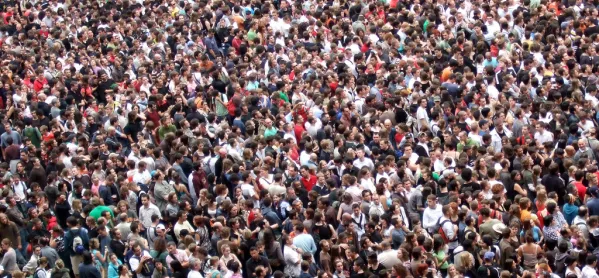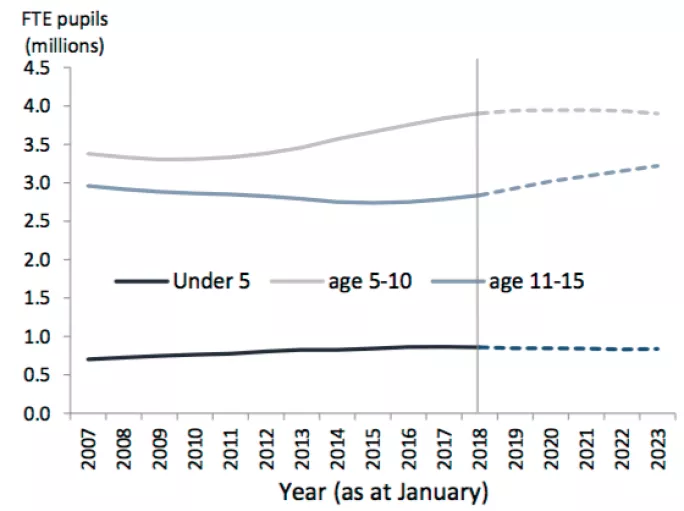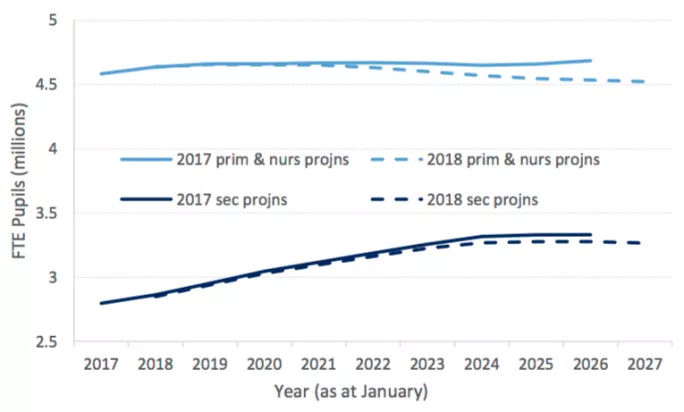
- Home
- Need to know: Pupil numbers
Need to know: Pupil numbers

The government has released new projections for the number of pupils in England’s schools over the next 10 years.
The Department for Education has revised down its previous predictions, but does this mean the teacher recruitment crisis will not be as bad as feared in years to come?
Here is what you need to know.
What is the situation at the moment?
According to the figures, there are currently 7.6 million children and young people in state-funded schools in England.
The majority - 4,635,000 - are in primary schools and maintained nurseries, with a further 2,849,000 in secondary schools, 100,000 in special schools and 16,000 in alternative-provision settings.
What is predicted to happen in the future?

The total school population is projected to peak at 7,968,000 in 2024, which is 4.8 per cent above the current level. It is then expected to fall over the following three years.
As you would expect, there is a lag between population trends in primary schools and secondary schools.
The primary population is set to peak next year at 4,656,000 children, capping 10 consecutive years of growth. It is then projected to fall in each subsequent year, with 133,000 fewer children expected to be in primary schools in 2027, compared with 2019.
The rise in the secondary school population is expected to continue for several years after the primary population has started to fall, as the children in the earlier primary bulge work their way through the system.
The number of children in secondary schools started to grow in 2016, and this increase is projected to continue until 2025, when the number should hit 3,277,000 - which is 15 per cent above today’s figure.
It is predicted to remain the same in the following year, before dropping by 10,000 pupils in 2027.
How does this compare with previous predictions?

The government publishes its pupil projections annually, so it is possible to see how they vary from year to year.
The latest figures are notable for showing that the DfE thinks that pupil numbers in future years will be lower than it had previously thought.
Officials now believe that in 2026 there will be 201,000 fewer children and young people in the school system than they had predicted just a year ago.
The change is particularly pronounced in the primary sector, where there are expected to be 150,000 fewer pupils than originally anticipated.
So instead of last year’s prediction that the primary population would increase by 102,000 between 2017 and 2026, this year’s prediction is that the number will actually fall by 48,000 over the same period.
Why have the numbers changed?
The change to the DfE’s figures is a result of it using more up-to-date data in its calculations.
Last year’s pupil trend projections used data from the Office for National Statistics (ONS) from mid-2014. In contrast, the latest figures use ONS data from mid-2016, which contains more recent information about fertility, migration and life expectancy.
The DfE’s analysis says a lower than projected birth rate is the main reason why pupil projections are lower than before.
Its commentary says “most of the difference in the new underlying ONS national population projections is a drop in projected figures at age 0 (birth) which, over the timescale of this projection, feeds into the nursery and primary population”.
Does this mean there is no longer a teacher recruitment challenge?
Although the government has revised down the number of pupils it thinks will be in the system in the years ahead, the statistics still show there is a big challenge ahead.
There are still expected to be 428,000 more children in mainstream, state-funded secondary schools by 2026. These extra pupils in the system will require teachers.
And the latest figures for Ucas show that the number of people applying for teacher training courses in September 2018 is down 7 per cent compared with the same time last year.
Tes research published earlier this year revealed the scale of the problem when it found that 47,000 extra secondary teachers would be needed by 2024 to cope with the explosion in secondary pupil numbers.
That represents a 22.5 per cent increase on the number of secondary teachers currently in the system and demonstrates why a much bigger fall in pupil numbers would be required to make the issue go away.
Register with Tes and you can read five free articles every month, plus you'll have access to our range of award-winning newsletters.
Keep reading for just £4.90 per month
You've reached your limit of free articles this month. Subscribe for £4.90 per month for three months and get:
- Unlimited access to all Tes magazine content
- Exclusive subscriber-only stories
- Award-winning email newsletters
You've reached your limit of free articles this month. Subscribe for £4.90 per month for three months and get:
- Unlimited access to all Tes magazine content
- Exclusive subscriber-only stories
- Award-winning email newsletters



